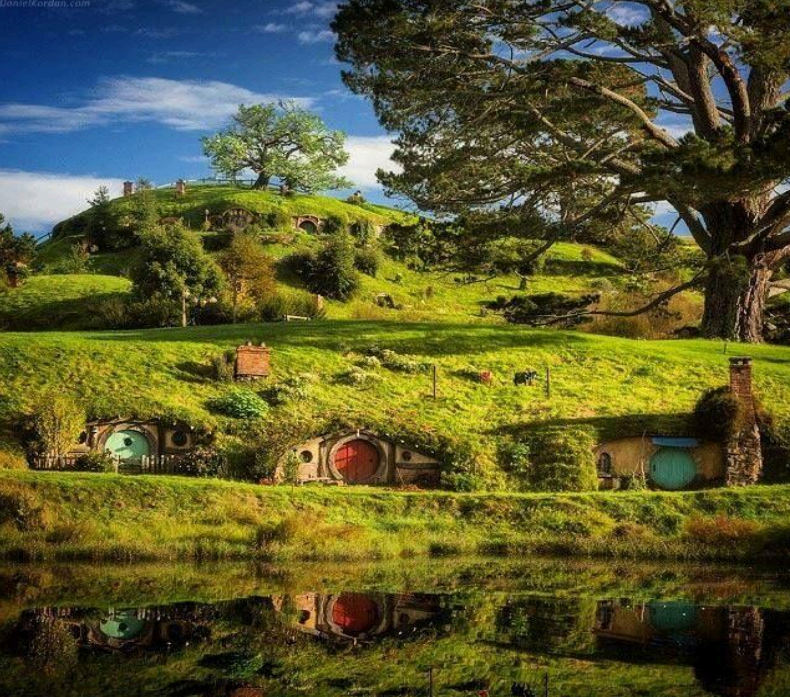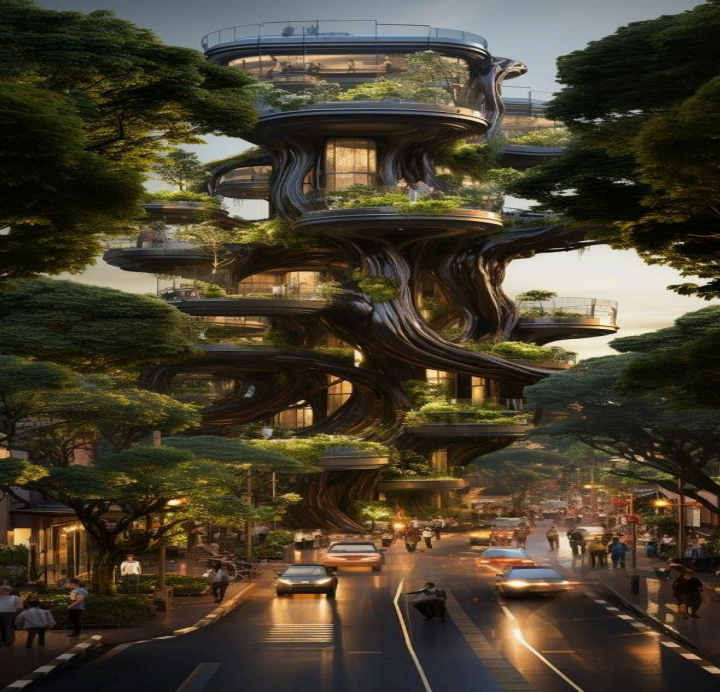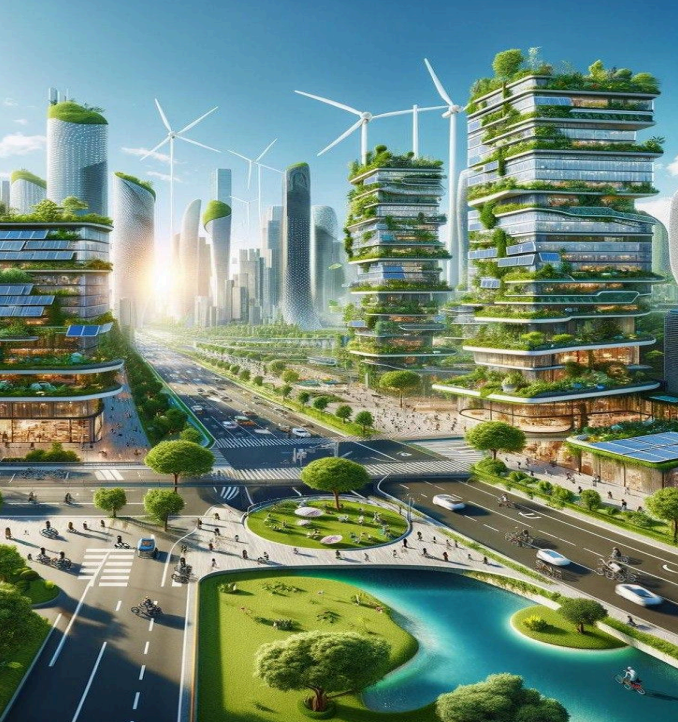Going back further to Nature: Crafting a Biophilic Cityscape
 Illustration 1: Shire from ‘The Lord of the Rings’. A utopian fairyland where peace resides.
Illustration 1: Shire from ‘The Lord of the Rings’. A utopian fairyland where peace resides.
If one goes to today’s social media, most of the reels are about people who are tired of today’s fast-paced life and want to live a simple life in a small wooden cabin in the forest, in the mountains, in the fields. We also see netizens appreciating that stuff in the comment box. What is
this? Why is it happening?
In the 21st century, the contamination of air, water, and land has reached alarming levels, where any improvement in air quality becomes newsworthy. Urban life in the metro cities is increasingly suffocating due to environmental concerns, exemplified by the significant decline in
volume and number of urban trees, the rampant pollution and excessive overuse of natural resources. This escalating environmental crisis has prompted serious introspection on the legacy we leave for future generations. Consequently, a global imperative for a “sustainable lifestyle” has emerged, emphasizing a return to nature. Many of the current bustling cities or urban landscapes are being problematic due to their unsustainable designs and disconnect from nature. They consume too much and produce too much waste and pollution. They also isolate people from nature and each other, resulting in long-term social and psychological problems. These cities are not resilient to the challenges of climate change, population growth, and rising pandemics. Leave alone ‘Smart Cities’, they are not even ‘Livable’ considering a large section of people are excluded from basic amenities and freedom of choices for their self-development. Therefore, amidst this concrete jungle, many people in contemporary times want to go back to the villages or farms to feel the purity of nature and natural landscapes. This idea of connecting to nature gives a subconscious feeling of tranquility and peace. This desire to return to villages, popularly as ‘Going back to nature’ to embrace nature everyday. This longing and urge of people to go back to nature is usually reflected in their day-to-day activities. For example, lately, there is a significant rise in listening to white noise for getting peaceful sleep. White noise is basically the pleasant sound of nature, such as waterfall, rain, or wind. This gives a feeling of living in a natural environment. You usually calm down listening to this type of music and eventually have a good night’s sleep, don’t you?
Imagine living in a city where one can breathe fresh air, enjoy green spaces, and connect with nature every day. A city where you can access the latest technologies and services without compromising the environmental affinity. A city where you can experience harmony with nature.
This is not a fantasy, but a vision of biophilic cityscape. At the core of this feature article lies a futuristic concept of a Biophilic City, an Eco-City, or a Green City 1. It envisions a landscape where modern technologies coexist with the lush forests, blurring the lines between the artificial and the organic.
Illustration 2: Envisioning a city where skyscrapers stand in harmony with towering trees, where smart infrastructure works hand in hand with the natural ecosystem.
What is a biophilic city?
Illustration 3: An idea of Green City/ Eco-city or Biophilic City
Broadly saying, a biophilic city is a city that puts nature first in its design and functioning. It recognizes the essential need for daily human contact with nature as well as the many environmental values provided by nature. Biophilic design incorporates environmental features of construction such as color, water, air, sunlight, plants, animals, natural materials, landscapes, and geology. It also includes natural shapes and forms, such as botanical, animal, and shell motifs, and architecture that ensures optimal and sustainable use of natural resources. Moreover, biophilic design simulates natural features, such as architecture, and design. Biophilic design also considers the natural patterns and processes in the landscape, as well as geological or ecological features of the place (Beatley). One of the key features of a biophilic city is the incorporation of green spaces throughout its landscape. Parks, gardens, and urban forests are seamlessly integrated into the urban spaces. These green spaces not only serve aesthetic purposes but also play a crucial role in mitigating the adverse effects of urbanization, such as air pollution and heat island effects. In addition to green spaces, innovative solutions such as vertical gardens, rooftop farms, and smart grid systems are employed to maximize the use of limited space while minimizing the ecological footprint. Basically, it’s made up of eco-friendly elements and fulfills ecological sustainability.
How can we create biophilic cities?
Creating biophilic cities with the help of available futuristic technologies is not impossible, but what it requires is a radical shift in our mindset and behavioral approach The realization of such a city necessitates the collaboration and commitment of various stakeholders, including city planners, architects, policymakers, and residents. We need to integrate nature into every aspect of our urban life like hobbits do in the shire.
We need to use futuristic technologies, not to replace and displace nature, but to embrace it. Enhancing the connection between humans and nature is the key.
- Renewable energy sources and systems that can harness the power of nature, such as solar, wind, hydro, and biofuels, and reduce the dependence on conventional fossil fuels.(Beatley)
- Green infrastructure and futuristic technological systems that can do the functions of nature, such as green roofs, walls, rain gardens, wetlands, and urban forests, and provide multiple benefits from rain water harvesting to urban cooling. (Beatley)
- Design a system for proper use of biodegradable and recyclable materials and products that can reduce the waste generation and disposal.
- Artificial Intelligence (AI) can be used to optimize the use of resources, such as energy and water, and ensure that they are used in the most efficient and sustainable way possible. For example, AI-powered sensors can be used to monitor air quality and alert city officials if pollution levels exceed safe limits.
In a biophilic city, the benefits extend beyond mere aesthetics. Biophilic cities are not only friendly for the environment, but also for human health, happiness and mental well-being. Modern research has shown that exposure to nature can reduce stress, improve mood, enhance
cognitive performance, boost immune system, and increase lifespan. (Morse)
Illustration 4: I believe this connection with nature nourishes an inquisitive mind, perhaps, it might enlighten you. Don’t we know Bhumisparsha Mudra of Buddha? It was nothing but a symbolic gesture of reconnection with nature, wasn’t it?
While imagining this, I am well aware of the possibility where people can easily dismiss this as a utopian or fantastical concept. This vision faces a lot of skepticism due to its perception of impossibility in the near future. Yet, I personally believe that utopia, in its essence, can evolve
into reality through the adept use of futuristic technologies. We have always seen that in history. Many of the scientific fantasies of the late 20th century have come true today, we all witness that in our day-to-day life today. While acknowledging the challenges inherent in achieving this symbiosis, it becomes evident that this endeavor is crucial for crafting a sustainable lifestyle. The integration of urban spaces with nature represents not only an aesthetic landscape but a pragmatic solution for optimal use of natural resources without burdening our Mother Earth.
Biophilic cities are not a utopian or fantasy idea, but a realistic and feasible one. With the use of futuristic technologies, humankind can achieve this idea and make it real for the next generations. These cities can effectively reduce their ecological footprint, minimize resource
consumption, and combat the adverse effects of urbanization. They are the key to a sustainable lifestyle and optimal use of natural resources without being a burden on the earth. They are the cities of the future, and the future is now.
Works Cited
Beatley, Timothy. “Biophilic Cities: What Are They?” Springer Link, 9 November 2017, https://link.springer.com/chapter/10.5822/978-1-59726-986-5_3. Accessed 28 January 2024.
Morse, Olivia. “Biophilic Cities: Good for Both Environmental Health and Human Health – USC Viterbi School of Engineering.” USC Viterbi School of Engineering, 21 April 2021, https://illumin.usc.edu/biophilic-cities-good-for-both-environmental-health-and-human-health/. Accessed 28 January 2024.






Recent Comments